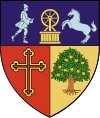Băile Govora
Băile Govora | |
|---|---|
Town | |
 | |
| Country | Romania |
| County | Vâlcea County |
| Status | Town |
| Government | |
| • Mayor | Mihai Mateescu (Socialist Alliance Party) |
| Population (2002) | |
• Total | 3,147 |
| Time zone | UTC+2 (EET) |
| • Summer (DST) | UTC+3 (EEST) |
| Website | Primăria Băile Govora |
| Year | Pop. | ±% |
|---|---|---|
| 1930 | 910 | — |
| 1948 | 1,156 | +27.0% |
| 1956 | 1,590 | +37.5% |
| 1966 | 2,189 | +37.7% |
| 1977 | 2,749 | +25.6% |
| 1992 | 3,023 | +10.0% |
| 2002 | 3,147 | +4.1% |
| 2011 | 2,353 | −25.2% |
| Source: Census data | ||
Băile Govora (or just Govora) is a Romanian spa town in Vâlcea County, about 20 km (12.43 mi) south-west of Râmnicu Vâlcea and west of the Olt river. Notable features of the town (beside its mineral springs, recommended for a variety of ailments) include the Govora abbey (built in the 15th century and consolidated by Matei Basarab and later by Constantin Brâncoveanu) and the nearby Dintr-un lemn Monastery (16th or 17th century; the legend of its origin was recorded by Paul of Aleppo).
Govora Abbey was the site where Matei Basarab introduced the first printing press in Wallachia – where the first written code of laws in Romanian was published, Pravila de la Govora, in 1640.
The town administers three villages: Curăturile, Gătejești and Prajila.
The resort is at an altitude of 360–380 metres (1,180–1,250 ft) and the whole area is surrounded by forests. The name of the city, Govora, comes from Thracian-Dacian dialect and means "dent", a valley with many springs.
In 1876 a local discovered salty water and mud good for rheumatic treatments. About ten years later the first base with warm baths was built. After 1950, Govora became a city and also resort along with creating bases for treatment, hotels and hostels were built. But the official opening of the resort took place in 1910 once with the first hotel.
Resort is recommended[by whom?] for those seeking peace and relaxation but especially those with respiratory and rheumatic diseases. In the late 1980s a hotel complex was built with all the conditions for treatment and accommodation. Today the resort can receive annually, over 1400 tourists. Beside treatment tourists can visit historical monuments and arts from Dacian and Roman artifacts.
External links
- Baile Govora spa direct link: Băile Govora spa site
- Romanian tourism site: Băile Govora and Dintr-un lemn Monastery
- Template:Ro icon Vâlcea County tourist spots: Băile Govora
- Template:Ro icon Information about Govora Resort


